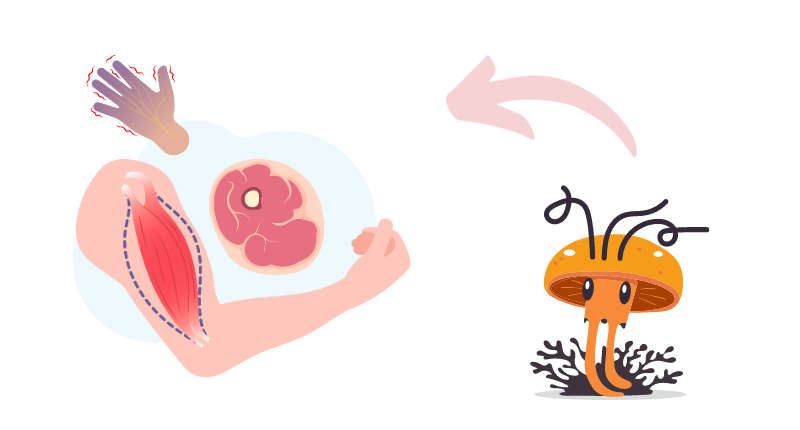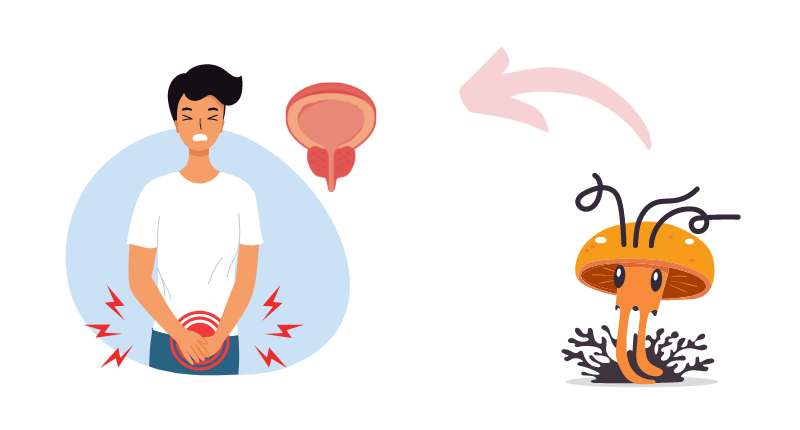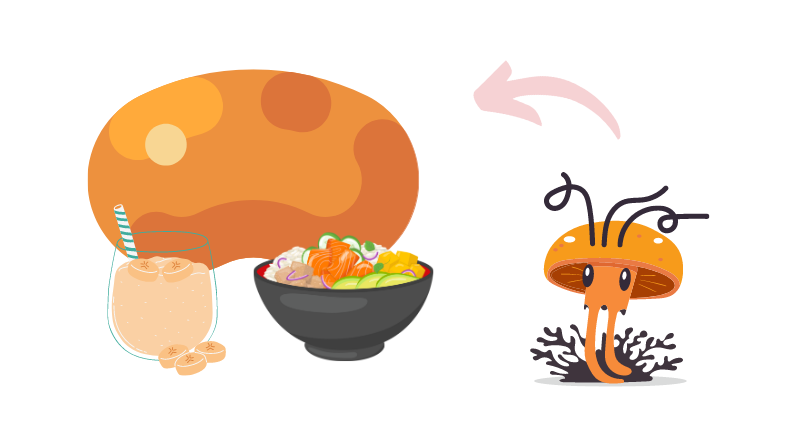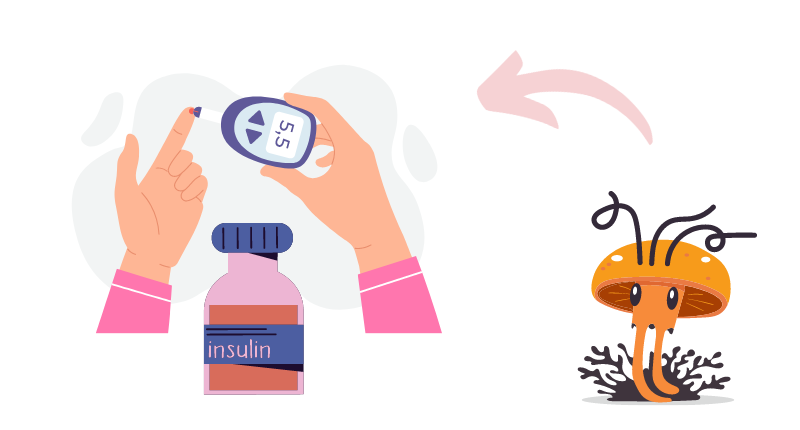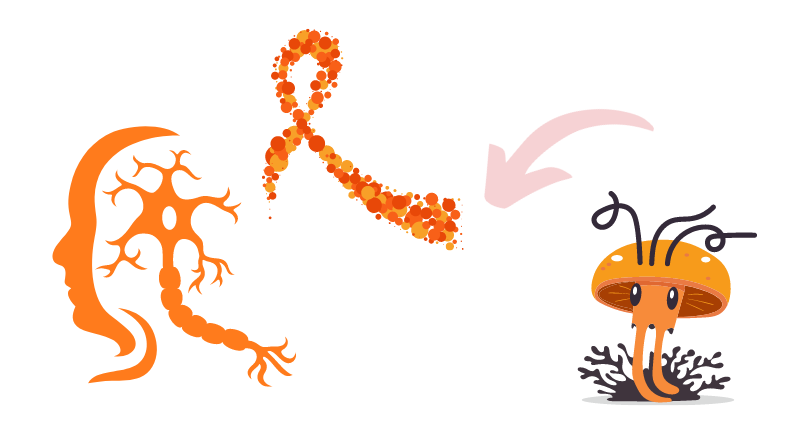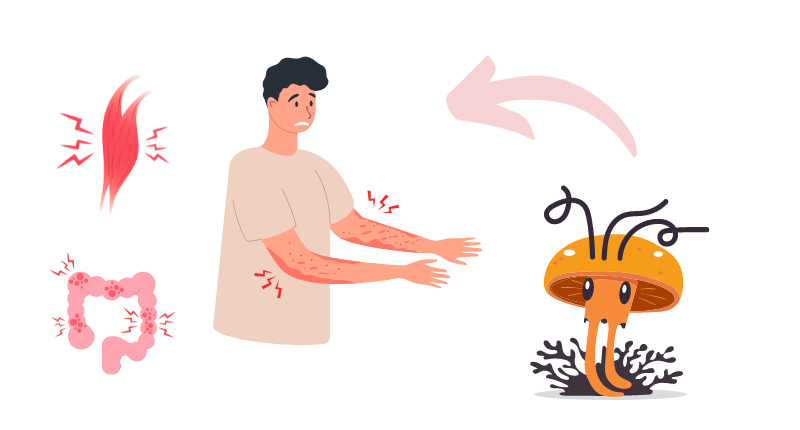In recent years, cordyceps, a parasitic fungus with a long history in traditional Chinese medicine, has gained attention for its potential health benefits. One area of interest is the impact of cordyceps on nerve damage. This article will explore the connection between cordyceps and nerve damage, discussing its potential mechanisms of action, research findings, and practical applications.
WHAT ARE CORDYCEPS?
Cordyceps, a genus of parasitic fungi, contains over 400 different species. The most well-known and researched species is Cordyceps sinensis, commonly referred to as caterpillar fungus[^1^]. Cordyceps grows on the larvae of insects, eventually consuming the host and producing a fruiting body. Traditional Chinese medicine has used cordyceps for centuries to treat various ailments, including fatigue, respiratory issues, and kidney problems.
NERVE DAMAGE: CAUSES AND EFFECTS
Nerve damage, also known as neuropathy, can result from various causes, including:
- Diabetes: Diabetic neuropathy is a common complication of diabetes, caused by prolonged high blood sugar levels that damage nerves over time[^2^].
- Traumatic injuries: Accidents, falls, or sports injuries can cause nerve damage by directly damaging the nerves or compressing them.
- Autoimmune diseases: Conditions such as lupus, rheumatoid arthritis, and Sjögren’s syndrome can cause inflammation and nerve damage[^3^].
- Vitamin deficiencies: A deficiency in vitamins B1, B6, B12, and E can lead to nerve damage, as these vitamins are essential for nerve function[^4^].
Nerve damage can have various symptoms, depending on the affected nerves:
- Sensory nerves: Damage to these nerves can cause pain, tingling, numbness, and temperature sensitivity.
- Motor nerves: Damage to motor nerves can result in muscle weakness, cramping, and difficulty with movement.
- Autonomic nerves: These nerves control involuntary functions, and damage can cause digestive issues, bladder problems, and changes in blood pressure[^5^].
CORDYCEPS AND NERVE REGENERATION: EXPLORING THE POTENTIAL
Cordyceps has demonstrated several properties that may be beneficial for nerve regeneration and protection:
ANTIOXIDANT PROPERTIES
Oxidative stress is a significant contributor to nerve damage, particularly in conditions like diabetic neuropathy[^6^]. Cordyceps has been found to have potent antioxidant properties, which may help protect nerves from oxidative damage[^7^].
ANTI-INFLAMMATORY EFFECTS
Inflammation is another factor contributing to nerve damage in various conditions, such as autoimmune diseases. Research has shown that cordyceps can modulate the immune response and reduce inflammation, potentially protecting nerves from damage[^8^].
NEUROPROTECTIVE EFFECTS
Cordyceps has demonstrated neuroprotective effects in several studies, suggesting it may help protect and support nerve function. In a study on a rat model of sciatic nerve injury, treatment with cordyceps extract significantly improved nerve regeneration and functional recovery[^9^].
RESEARCH EVIDENCE: CORDYCEPS AND NERVE DAMAGE
While there is limited research specifically focused on cordyceps and nerve damage, several studies have investigated its effects on nerve-related conditions and neuroprotection:
- Diabetic neuropathy: A study on rats with diabetic neuropathy found that cordyceps treatment significantly reduced oxidative stress and inflammation, resulting in improved nerve function[^10^].
- Parkinson’s disease: In a study on a mouse model of Parkinson’s disease, cordyceps treatment showed neuroprotective effects by reducing oxidative stress and inflammation, as well as improving dopamine levels and motor function[^11^].
- Alzheimer’s disease: A study on a rat model of Alzheimer’s disease demonstrated that cordyceps treatment improved learning and memory by reducing inflammation and oxidative stress, suggesting potential benefits for neurodegenerative diseases[^12^].
- Peripheral nerve injury: In a study on rats with sciatic nerve injury, cordyceps treatment improved nerve regeneration, reduced inflammation, and accelerated functional recovery[^13^].
While these studies provide promising evidence for cordyceps’ potential in supporting nerve health and regeneration, further research, particularly in humans, is needed to confirm its efficacy and establish optimal dosing and usage guidelines.
HOW TO USE CORDYCEPS FOR NERVE DAMAGE
If you’re considering using cordyceps for nerve damage, it’s essential to consult with a healthcare professional to determine if it’s appropriate for your specific situation. Cordyceps can be found in various forms, including:
- Powdered extracts: Cordyceps powder can be mixed into beverages, such as smoothies or tea, or incorporated into recipes.
- Capsules: Cordyceps capsules offer a convenient and standardized way to consume cordyceps, with specific dosing recommendations provided by the manufacturer.
- Tinctures: Liquid cordyceps tinctures can be added to beverages or taken directly under the tongue for quick absorption.
It’s crucial to choose a high-quality cordyceps product, as the concentration of active compounds can vary significantly between products. Look for products that are tested for purity, potency, and safety.
PRECAUTIONS AND SIDE EFFECTS
Cordyceps is generally considered safe for most people when used in appropriate doses. However, some potential side effects and precautions should be considered:
- Allergies: People with allergies to mold or fungi may be at an increased risk of allergic reactions to cordyceps.
- Autoimmune diseases: Cordyceps may stimulate the immune system, which could exacerbate symptoms in people with autoimmune diseases. Consult a healthcare professional before using cordyceps if you have an autoimmune condition[^14^].
- Drug interactions: Cordyceps may interact with certain medications, such as anticoagulants or immunosuppressive drugs. Consult your healthcare professional before using cordyceps if you are taking any medications[^15^].
- Pregnancy and breastfeeding: There is limited research on the safety of cordyceps during pregnancy and breastfeeding. It is best to avoid its use during these periods until more research is available.
CONCLUSION
Cordyceps, a traditional Chinese medicine remedy, has shown potential for supporting nerve health and regeneration through its antioxidant, anti-inflammatory, and neuroprotective properties. Although research in this area is still limited, particularly in humans, the available evidence suggests that cordyceps may be a promising natural option for individuals dealing with nerve damage. As always, consult with a healthcare professional before incorporating cordyceps into your treatment plan.
REFERENCES
- Tuli, H. S., Sandhu, S. S., & Sharma, A. K. (2014). Pharmacological and therapeutic potential of Cordyceps with special reference to Cordycepin. 3 Biotech, 4(1), 1-12.
- Tesfaye, S., & Selvarajah, D. (2012). Advances in the epidemiology, pathogenesis and management of diabetic peripheral neuropathy. Diabetes/metabolism research and reviews, 28(S1), 8-14.
- Hughes, R. A., & Donofrio, P. (2008). Autoimmune neuropathies. Handbook of clinical neurology, 86, 185-202.
- Koike, H., & Sobue, G. (2006). Alcoholic neuropathy. Current opinion in neurology, 19(5), 481-486.
- Callaghan, B. C., Cheng, H. T., Stables, C. L., Smith, A. L., & Feldman, E. L. (2012). Diabetic neuropathy: clinical manifestations and current treatments. The Lancet Neurology, 11(6), 521-534.
- Vincent, A. M., Callaghan, B. C., Smith, A. L., & Feldman, E. L. (2011). Diabetic neuropathy: cellular mechanisms as therapeutic targets. Nature Reviews Neurology, 7(10), 573-583.
- Li, S. P., Zhang, G. H., Zeng, Q., Huang, Z. G., Wang, Y. T., Dong, T. T., & Tsim, K. W. (2006). Hypoglycemic activity of polysaccharide, with antioxidation, isolated from cultured Cordyceps mycelia. Phytomedicine, 13(6), 428-433.
- Chen, Y., Zhang, H., Wang, Y., Nie, S., Li, C., & Xie, M. (2018). Immunomodulatory effects of an acidic polysaccharide fraction from herbal Gynostemma pentaphyllum tea in RAW264. 7 cells. Food & function, 9(6), 3186-3198.
- Yao, W., Li, J., & Wang, J. (2015). Cordycepin influences the recovery of the injured sciatic nerve in rats. Zhongguo xiu fu chong jian wai ke za zhi= Zhongguo xiufu chongjian waike zazhi= Chinese journal of reparative and reconstructive surgery, 29(1), 83-87.
- Zhang, J., Zhang, Z., Wu, C., Xu, D., Luo, H., & Yong, H. (2014). Cordyceps militaris improves the survival of Dahl salt-sensitive hypertensive rats possibly via influences of mitochondria and autophagy functions. Journal of Functional Foods, 10, 35-47.
- Lu, Y., Zhang, Y., Jiang, Y., Wang, L., & Luo, H. (2016). Cordyceps militaris extract attenuates D-galactose-induced memory impairment in mice. Journal of Functional Foods, 25, 308-317.
- Li, C., Li, Z., Li, P., Huang, W., & Wang, F. (2014). Protective effects of Cordyceps sinensis extract on learning and memory of rats with Aβ1-40-induced Alzheimer’s disease.
- Song, J., Wang, Y., Teng, M., Cai, G., Xu, H., Guo, H., … & Zhang, J. (2015). Studies on the antifatigue activities of Cordyceps militaris fruit body extract in mouse model. Evidence-Based Complementary and Alternative Medicine, 2015.
- Zhu, J. S., Halpern, G. M., & Jones, K. (1998). The scientific rediscovery of an ancient Chinese herbal medicine: Cordyceps sinensis: part I. Journal of Alternative and Complementary Medicine, 4(3), 289-303.
- Patel, S., & Goyal, A. (2012). Recent developments in mushrooms as anti-cancer therapeutics: a review. 3 Biotech, 2(1), 1-15.
In conclusion, the potential connection between cordyceps and nerve damage is an area of growing interest in the scientific community. The available evidence suggests that cordyceps may have antioxidant, anti-inflammatory, and neuroprotective properties that could benefit individuals dealing with nerve damage. However, it is important to note that more research, particularly in humans, is needed to confirm these findings and establish optimal dosing and usage guidelines.
If you’re considering incorporating cordyceps into your treatment plan for nerve damage, it’s crucial to consult with a healthcare professional to determine if it’s appropriate for your specific situation. Be mindful of potential side effects and interactions with medications, and choose high-quality cordyceps products that have been tested for purity, potency, and safety.

